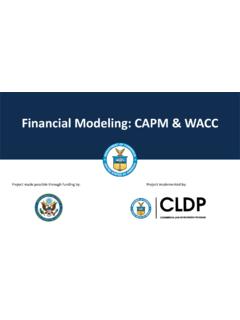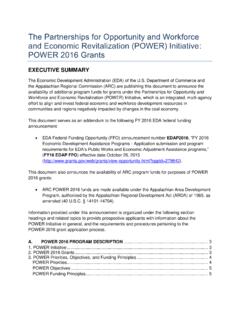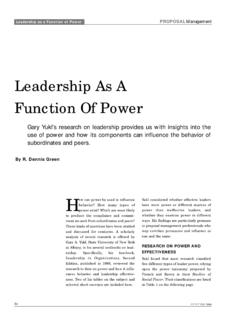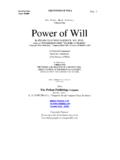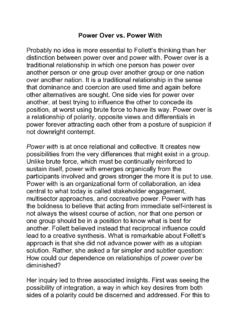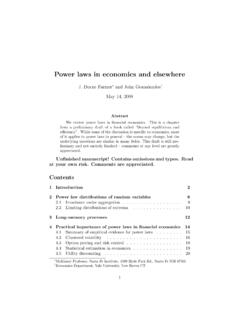Transcription of Understanding Power Project Procurement
1 UnderstandingPower ProjectProcurementUnderstanding Power Project ProcurementPOWER AFRICA Understanding SERIES (VOL 3)Funded byDeveloped byInstitutional PartnersTable of ContentsHANDBOOK INTRODUCTIONF orewordIntroductionCONTEXT AND OBJECTIVESM arket OverviewStakeholdersProcurement ObjectivesEnabling EnvironmentsPLANNING FOR PROCUREMENTU nderstanding the Current Power MarketProcurement PlanningTechnology and Resource ConsiderationsSite SelectionThe Role of External AdvisorsINTRODUCING Procurement TYPESE stablished Procurement Models51015192329444853636670 COMPETITIVE PROCUREMENTO verview of Competitive ProcurementExpressions of InterestRequest for Quali cationsRequest for ProposalsEvaluation and AwardDIRECT NEGOTIATIONSO verview of Direct NegotiationsProcess of Direct NegotiationsFEED-IN TARIFFSO verview of Feed-In TariffsFiT Programme ProcessesSELECTING A Procurement PROCESSI nherent Advantages & DisadvantagesAdditional ConsiderationsComplaints and Complaint MechanismsAPPENDICESG
2 LossaryAcronymsResources7683869210110911 3119123126131136140149152 HandbookIntroductionForewordIntroduction ForewordAccess to the energy that is needed to sustain our contemporary andconnected life represents perhaps the greatest development challengeof our time. Whether it is the Power to operate a factory or even thesimple act of charging a cell phone, individual access to reliable,a ordable electricity underpins the ability to participate in the moderneconomy. And yet, despite this fundamental connection betweenprosperity and Power , estimates suggest that almost a quarter of theworld's population lacks secure access to energy. The problem isparticularly acute in Sub-Saharan Africa, where a full two-thirds of thepopulation lacks access to of the challenge in delivering the Power that the world sodesperately needs is the inherent complexity of Power projectdevelopment.
3 Power projects are unique in that they are meant toproduce a public good, through a private Project , and within a highly-regulated market. Despite growing investment interest in powerprojects, emerging markets continue to su er from delays due toproject development strategies that are ine cient, costly and/orplagued by corruption. These delays may cause even the mostdedicated developer to walk away from a Project and, worst of all, leavethe public with the double loss of both delayed delivery of Power andfurther destabilisation of an already challenging response to these delays, Power markets have adopted a set ofprocedures to manage the orderly planning, negotiation andconstruction of Power projects. This process combines thetransparency and competitiveness of Procurement with the legal,technical and nancial planning for infrastructure development andhas enabled governments and the private sector to work together todeliver Power projects on a timely and cost-e cient basis.
4 For the5 Understanding Power Project Procurement purposes of this handbook, we will describe this collection ofprinciples as Power Project handbook is intended to provide the reader with an overview ofthe mechanisms and strategy behind successful Power ProjectProcurements. For those that are new to the concept of procurementgenerally, or the particulars of Power projects speci cally, werecommend reading the early chapters of the book to develop anunderstanding of the framework within which a Procurement shouldoperate to be successful. For those who are more experienced inprocurement matters, you may wish to proceed directly to Chapter Xfor a comparison of Procurement options. The handbook also includesseveral break-out boxes with insights from practitioners and otherexamples that help to place the Procurement principles in a powermarket group of authors who prepared this handbook, all of whomcontributed their precious time freely, were gathered fromgovernments, development nance institutions, Project developers,law rms and advisors, and have extensive experience in successfullydeveloping Power projects.
5 Our hope is that by establishing a commonunderstanding of the core elements of e ective Power projectprocurement, this handbook will aid governments in their mission tosecure increased access to Power for the public. The principlesoutlined in this handbook can also aid the private sector in its e ortsto serve as a productive partner for Power Project development inemerging handbook was produced using the Book Sprint( ) method, which allows for the dra ing,editing and publishing of a complete book in just ve days. Along with" Understanding Power Purchase Agreements," " Understanding PowerProject Financing," and " Understanding Natural Gas and LNG6 Understanding Power Project PROCUREMENTO ptions," this is the fourth book in Power Africa's Understandingseries to be produced using the BookSprints method.
6 Using thismethod, the authors were able to channel the insights gathered fromhours of debate and brainstorming into text and illustrations you will nd in these pages. The result is a plain-language resource that doesnot represent the opinions of any one author, but rather the decades ofcollective wisdom within the borrow an old adage, if you ask 16 Procurement experts about howto guarantee fast and cheap Power Project development, you are likelyto get 17 answers. This was certainly our experience as a group ofauthors when preparing this handbook. During our deliberations, itbecame clear that there are no absolutes when it comes toprocurement policy. For example, competitive tenders are not alwaysfast, and direct negotiations are not always easier. What is certain,however, is that if one follows the core principles common to mostsuccessful Power Project procurements, there is a signi cantly greaterlikelihood of reaching targets for speed, cost and transparency.
7 Thereis also the potential of further improving outcomes as the procurementprinciples are re ned, Project by Project . Ultimately, as this handbookattempts to make clear, Power Project Procurement is not a science ofrigid rules but rather an art of vision and authors would like to thank our BookSprints facilitator BarbaraR hling for her inspiring spirit and steadfast guidance throughout thenearly 75-hour dra ing process. The authors would also like to thankHenrik van Leeuwen and Lennart Wolfert for turning our rushedscribbles into beautiful and meaningful illustrations. The tireless workof BookSprints remote sta , Raewyn Whyte, Julien Taquet andKaterina Michailidi, should also be recognised. The authors would alsolike to single out Sana Akili (CLDP) for her role as the target reader forthe BookSprint; her diligent reading (and re-reading) of the bookhelped to ensure that it was written in Power Project PROCUREMENTC onsiderable planning and development went into the conceptualisation of the Power Project Procurement handbook.
8 The authors would like to recognize the following individuals and institutions that helped focus dialogue to build a consensus around the need for this handbook: Vibuhti Jain, Albert Osueke, and Emily Wann ( Power Africa); Gadi Taj Ndahumba and Toyin Ojo (African Legal Support Facility); Nnamdi Ezera, Mohammed Loraoui, and Sheryl Bennett (Commercial Law Development Program). The authors would also like to recognise the generous funding and logistical support of Power Africa, the United States Agency for International Development and the African Legal Support continue the tradition of open source knowledge sharing that is at the core of the Power Africa Understanding series, this handbook is issued under the Creative Commons Attribution-NonCommercial-ShareAlike International License (CC BY NO SA). In selecting this publication license, anyone is welcome to copy, excerpt, rework, translate and re-use the text for any non-commercial purpose without seeking permission from the authors, so long as the resulting work is also issued under a Creative Commons License.
9 The handbook is initially published in English with French, Portuguese and Spanish editions soon to follow. The handbook is available in electronic format at , and print format by contacting Mohamed Badissy (CLDP) at or ALSF at sincerely hope that the knowledge and insight shared in thishandbook will aid public and private stakeholders as they seek to charta pathway for the predictable and e cient Procurement of powerprojects. In many ways, the journey of the authors from inquiry tounderstanding mirrors the path from conception to construction thatpower projects must follow. Thank you for considering this8 Understanding Power Project Procurement contribution and for joining the authors on their mission to deliveringon the promises of a more electri ed ,The Authors9 Understanding Power Project PROCUREMENTI ntroductionMany developing countries are yet to achieve universal electricityaccess for their citizens.
10 Although various energy resources could beused to generate electricity, such as solar, wind, hydroelectric,geothermal, natural gas, and coal, and are available in abundance, morethan billion people remain without access to electricity. Access toa ordable and reliable electricity plays a critical role in economicdevelopment, employment creation and example, the International Energy Agency has estimated thatAfrica needs to develop more than 250 gigawatts (GW) of additionalgeneration capacity, and associated transmission and distributioninfrastructure, from 2017 to 2030, to ful l the unmet demand forelectricity. This equates to an investment of approximately US$275billion in additional generation capacity alone. Beyond Africa, manyother countries require signi cant investment in new powergeneration to keep up with the growing demand for Procurement of Power generation projects is at the centre ofaddressing these critical needs.

